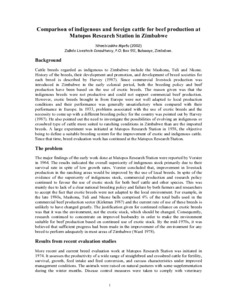Resource information
Cattle breeds regarded as indigenous to Zimbabwe include the Mashona, Tuli and Nkone. History of the breeds, their development and promotion, and development of breed societies for each breed is described by Harvey (1987). Since commercial livestock production was introduced in Zimbabwe in the early colonial period, both the breeding policy and beef production have been based on the use of exotic breeds. The reason given was that the indigenous breeds were not productive and could not support commercial beef production. However, exotic breeds brought in from Europe were not well adapted to local production conditions and their performance was generally unsatisfactory when compared with their performance in Europe. In 1933, problems associated with the use of exotic breeds and the necessity to come up with a different breeding policy for the country was pointed out by Harvey (1987). He also pointed out the need to investigate the possibilities of evolving an indigenous or crossbred type of cattle more suited to ranching conditions in Zimbabwe than are the imported breeds. A large experiment was initiated at Matopos Research Station in 1938, the objective being to define a suitable breeding system for the improvement of exotic and indigenous cattle. Since that time, breed evaluation work has continued at the Matopos Research Station.


